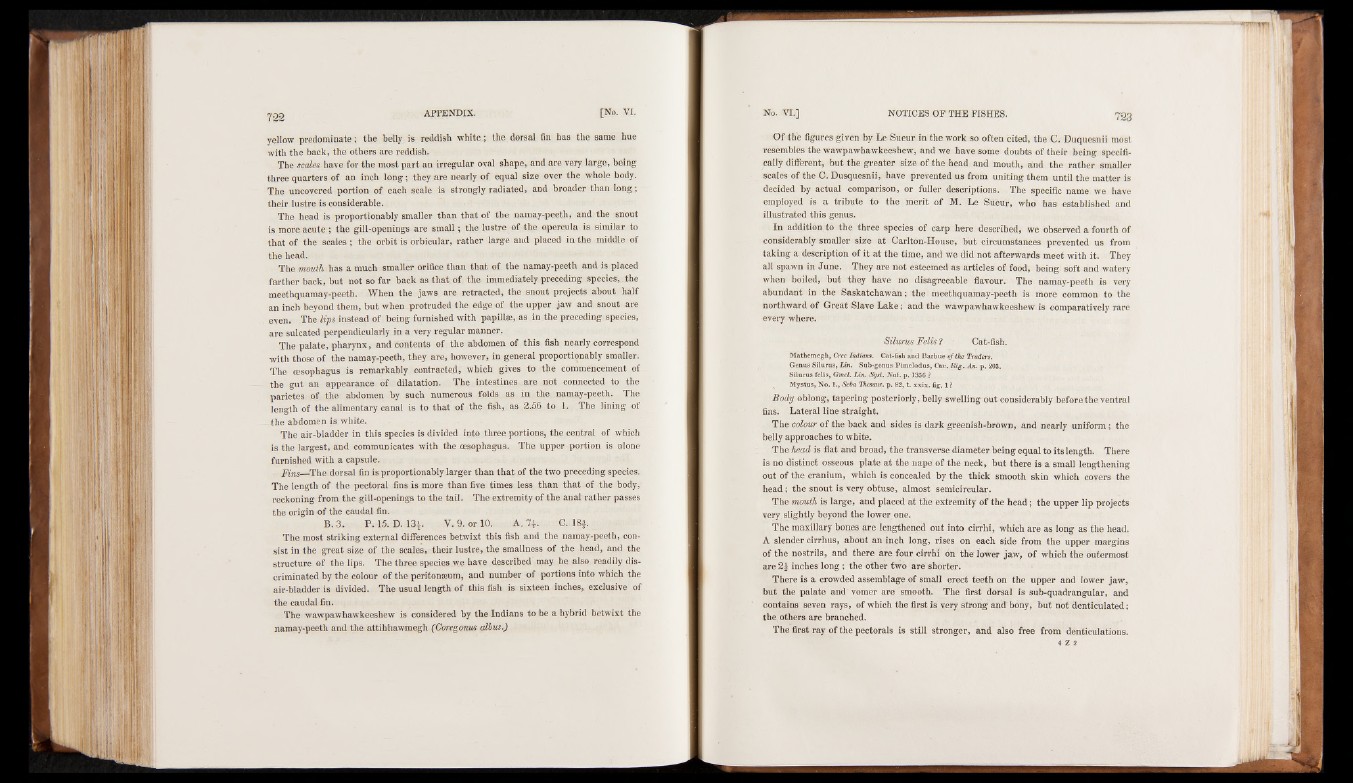
yellow predominate; the belly is reddish white,; the dorsal fin has the same hue
with the back, the others are reddish.
The scales have for the most part an irregular oval shape, and are very large, being
three quarters of an inch long; they are nearly of equal size over the whole body.
The uncovered portion of each scale is strongly radiated, and broader than long;
their lustre is considerable.
The head is proportionably smaller than that of the namay-peeth, and the snout
is more acute ; the gill-openings are small; the lustre of the opercula is similar to
that of the scales; the orbit is orbicular, rather large and placed in the middle of
the head.
The mouth has a much smaller orifice than that of the namay-peeth and is placed
farther back, but not so far back as that of the immediately preceding species,...the
meethquamay-peeth. When the jaws are retracted, the snout projects about half
an inch beyond them, but when protruded the edge of the upper jaw and snout are
even. The lips instead of being furnished with papillae, as in the preceding species,
are sulcated perpendicularly in a very regular manner.
The palate, pharynx, and contents of the abdomen of this fish nearly correspond
with those of the namay-peeth, they are, however, in general proportionably smaller.
The oesophagus is remarkably contracted, which gives to the commencement of
the gut an appearance of dilatation. The intestines,, are not connected to the
parietes of the abdomen by such numerous folds as in the namay-peeth. The
length of the alimentary canal is to that of the fish, as 2.56 to The lining of
the abdomen is white.
The air-bladder in this species is divided into three portions, the central of which
is the largest, and communicates with the oesophagus. The upper portion is alone
furnished with a capsule.
Fins—The dorsal fin is proportionably larger than that of the two preceding species.
The length of the pectoral fins is more than five times less than that of the body,
reckoning from the gill-openings to the tail. The extremity of the anal rather passes
the origin of the caudal fin.
B. 3. P. 15. D. 13*. V. 9. or 10. A. 7-f. a i8f
The most striking external differences betwixt this fish and the namay-peeth, consist
in the great size of the scales, their lustre, the smallness of the head, and the
structure of the lips. The three species we have described may be also readily discriminated
by the colour of the peritonaeum, and number of portions into which the
air-bladder is divided. The usual length of this fish is sixteen inches, exclusive of
the caudal fin.
The wawpawhawkeeshew is considered by the Indians to be a hybrid betwixt the
namay-peeth and the attihhawmegh (Coregonus dibits.)
Of the figures given by Le Sueur in the work so often cited, the C. Duquesnii most
resembles the wawpawhawkeeshew, and we have some doubts of their being specifically
different, but the greater size of the head and mouth, and the rather smaller
scales of the C. Dusquesnii, have prevented us from uniting them until the matter is
decided by actual comparison, or fuller descriptions. The specific name we have
employed is a tribute to the merit of M. Le Sueur, who has established and
illustrated this genus.
In addition to the three species of carp here described, we observed a fourth of
considerably smaller size at Carlton-House, but circumstances prevented us from
taking a description of it at the time, and we did not afterwards meet with it. They
all spawn in June. They are not esteemed as articles of food, being soft and watery
when boiled, but they have no disagreeable flavour. The namay-peeth is very
abundant in the Saskatchawan; the meethquamay-peeth is more common to the
northward of Great Slave Lake; and the wawpawhawkeeshew is comparatively rare
every where.
Silurus Felis ? • Cat-fish.
Mathemegh, Cree Indians. Cat-fish and Barbae o f the Traders.
Genus Silurus, Ian. Sub-genus Pimelodus, Cue. R ig . A n. p. 203.
Silurus felis, Gmel. L in . Syst. N at. p. 1356 ?
Mystus, No. 1., Seba Thesaur. p. 82, t. xxix. fig. 1 ?
Body oblong, tapering posteriorly, belly swelling out considerably before the ventral
fins. Lateral line straight.
The colour of the back and sides is dark greenish-brown, and nearly uniform; the
belly approaches to white.
The head is flat and broad, the transverse diameter being equal to its length. There
is no distinct osseous plate at the nape of the neck, but there is a small lengthening
out of the cranium, which is concealed by the thick smooth skin which covers the
head; the snout is very obtuse, almost semicircular.
The mouth is large, and placed at the extremity of the head; the upper lip projects
very slightly beyond the lower one.
The maxillary bones are lengthened out into cirrhi, which are as long as the head.
A slender cirrhus, about an inch long, rises on each side from the upper margins
of the nostrils, and there are four cirrhi on the lower jaw, of which the outermost
are 2£ inches long; the other two are shorter.
There is a crowded assemblage of small erect teeth on the upper and lower jaw,
but the palate and vomer are smooth. The first dorsal is sub-quadrangular, and
contains seven rays, of which the first is very strong and bony, but not denticulated;
the others are branched.
The first ray of the pectorals is still stronger, and also free from denticulations.
4 Z 2